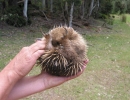The short snout Echidna is the only species of echidna Australia. It is easy to recognize by their sharp spines, short legs and long snout.
Measured between 30 and 45 cm.. and weigh between 2 and 5 kg. Found on Australia, including Tasmania. While found in all Australia, not as common in sydney as it used to be. The body, with the exception of the bottom, the face and the legs, It is covered with cream-coloured spines. These thorns, that it reach 50 length mm, they are actually modified hairs.
It lives in forests and woodlands, grasslands, heathland and arid environments.
The Echidna he is shy and moves slowly. Is solitary most of the year, but in time of mating several males may follow a female. Their activity patterns differ based on location and temperature – in the warmer areas of Australia is completely nocturnal, spending the rest of the day resting from the heat. It usually took refuge in rotten logs, stumps or Burrows, either under bushes. In more temperate areas activity occurs at sunset, while in South Australia echidnas are often active during the day, especially during the winter.
If it bothers you, the echidna usually lowers the head, and with vigorous digging, sinks quickly on the floor, leaving only the visible spines. Hard surfaces are screwed into a ball showing defensive thorns in all directions.
The Echidna are adapted for digging very fast, with short limbs and powerful claws. The claws on the hind legs are elongated and curved back, to allow the cleaning and personal hygiene among the thorns.
Surprisingly, the echidnas they are good swimmers. They have been seen crossing beaches for swimming and wash in the sea.
The echidnas males, like its relative the Platypus , they have a spur on each retropie. But, unlike platypuses the stimulus is blunt and the venom gland is non-functional.
With their pointed snout and sharp claws, the Echidna's short snout they feed on termes, ants and other insects that captures with its sticky tongue. Occasionally it helps strong nails to open ANTHILLS and Serranàa, especially when the Queen is found close to the surface. It also captures a lot of dirt in the process and it is expelled in feces.
Like the Platypus, the Echidna's short beak is a egg-laying mammal or monotremes and lays an egg at once. The eggs hatch after a few 10 days and the young, emerges blind and hairless. It will remain in the pouch around two months licking the milk that slips by the hairs of the mother until the inside of the bag. When the brood spines begin to grow, It is deposited on the inside of a hole dug by the mother, He returns occasionally to feed until they reach six months of age. Milk is pink in color due to a protein that contains iron.
The echidna is common and widespread. They are not as affected by deforestation as other native animals, since they can live anywhere that there is a supply of ants. Despite his cover of thorns, they have natural predators such as Eagles and demons from Tasmania, that even eat the thorns. They were the favorite food of the aborigines and the first white settlers, although now they are fully protected by law..
- Images of the Echidna's short snout
Photo 1: REUTERS / Tim Wimborne
Photo 2: wildlifeanimalz





